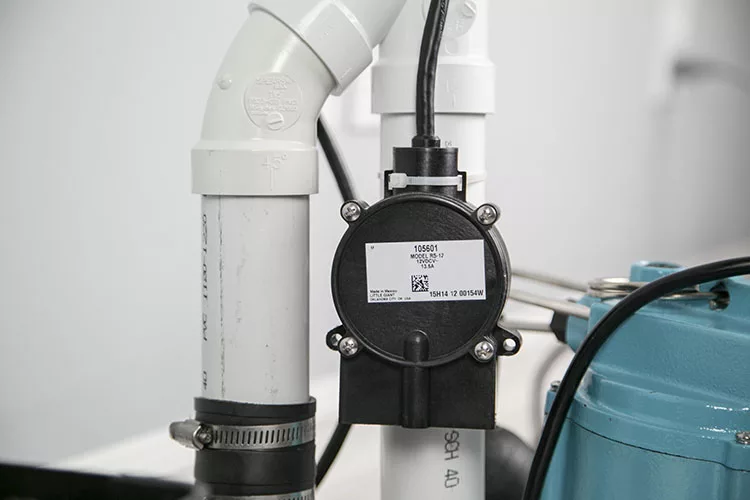Water removal is serious business, and sump pumps are tasked with doing more work than ever before. In commercial spaces, sump pump installations often mean balancing the building owner’s needs with the requirements set by the city or county government.
Building owners need a sump pump that effectively removes water from low-lying places and fits in as small a space as possible to preserve precious usable real estate space. They also need the submersible sump pump to perform as promised and operate quietly to eliminate any concerns about noise pollution.
From a municipality perspective, sump pumps are mandated by code more than ever, especially in new construction or renovation projects.
So how does an installer balance the building owner’s needs to get the most pumping power without taking over a space with loud and bulky equipment? A sump pump equipped with a diaphragm switch often overcomes many space issues — fitting where other equipment can’t and operating smoothly, even without a lot of room.
The Mechanics of a Diaphragm Switch
Sump pumps are designed to be used in areas prone to flooding, have dampness issues or where the water table may potentially rise above the structure of the building. They’re often housed in tight quarters such as basements, crawl spaces, loading docks, cooling towers and underground passageways.
Yet not all sump pits or sump applications are built the same, and not all sump pumps offer the same type of switching mechanisms for operation. Some toggle or pivot on a tether; others, like a diaphragm switch, work with pressure to activate.
Think of a diaphragm switch much like the diaphragm in your body that helps you breathe. As you breathe in, the diaphragm allows your lungs to fill with air and ensures you release the air smoothly and naturally. You’re not a balloon waiting to burst.
On a sump pump, a diaphragm switch — or what’s sometimes called an atmospheric pressure switch — works in a similar way, with smooth and consistent operation. As the water pressure rises in a basin, this presses against the diaphragm switch, activating the pump. When the water is removed or back to a predetermined level, the pump switches off.
Diaphragm switches were first introduced in the 1960s. Their design and construction are considered contractor-grade and ideal for permanent installations since the switches require limited maintenance.
Ideal for Small Areas
Diaphragm switches are housed either vertically or horizontally on a pump. Vertical diaphragm switches are housed at the top or bottom of a pump; horizontal switches are side-mounted.
Typically, vertical switches require a bigger footprint than horizontal diaphragm switches. This means a horizontal diaphragm switch can fit into smaller pits and other spaces that are limited radially. This space-saving feature can be a big benefit in areas where real estate is expensive or utility room space is limited.
Consider an old warehouse converted to a multiuse commercial and residential space in the Northeast. The building offered limited room belowgrade to house equipment, and that equipment needed to withstand harsh New England winters and handle high volumes of water during the spring when the water table rises.
The sump pump needed to operate quietly and not interrupt tenants during work or after hours. Horizontal diaphragm-activated submersible sump pumps met all the requirements for this application.
Better for Reliability
Since diaphragm switches use pressure created by rising water, there are no external floats to hang up on pipes or basin walls. Due to the orientation of the diaphragm, pumps with a horizontal diaphragm switch not only fit into smaller pits and spaces, but also operate more reliably.
Submersible pumps allow the sump pit to be covered with a lid, reducing pump noise and preventing debris from falling into the pit. An airtight lid also helps keep moist air from being released into the space. This is important if mechanical equipment is housed near the sump pump, as it often is in commercial spaces. Plus, a submersible sump pump’s electric motor will stay cooler when submerged in the basin water, resulting in longer performance life.
A school building in Michigan offers an example of when these features paid off. The school was located near a lake and was prone to water intrusion on its lowest level — an area where classrooms were located. A submersible sump pump with a diaphragm switch allowed the district to install a better, higher-performing pump for water removal without disturbing the nearby classrooms.
Sump pumps are essential in belowgrade spaces, eliminating excess water and reducing the chance of water damage and long-term water-related issues, such as mold. From an installer perspective, it may be known that a sump is required, but not all sump pits or sump applications are built the same.
Small pits, spaces limited radially and areas requiring reliable, proven operation can all benefit from the design and performance of a submersible sump pump equipped with an integral diaphragm switch.
Currently an engineering manager at Franklin Electric, Sean McCollum has had 25 years of experience working with the Little Giant Product line. Little Giant is a brand of Franklin Electric, a global leader in the production and marketing of systems and components for the movement of water and energy.




